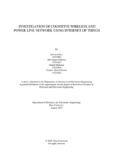| dc.contributor.advisor | Sabuj, Saifur Rahman | |
| dc.contributor.author | Roy, Onimesh | |
| dc.contributor.author | Shahriar, Md Atique | |
| dc.contributor.author | Mahmud, Shakib | |
| dc.contributor.author | Komol, Tanjim Ahmed | |
| dc.date.accessioned | 2019-09-19T07:00:11Z | |
| dc.date.available | 2019-09-19T07:00:11Z | |
| dc.date.copyright | 2019 | |
| dc.date.issued | 2019-08 | |
| dc.identifier.other | ID 15321001 | |
| dc.identifier.other | ID 15321023 | |
| dc.identifier.other | ID 15321019 | |
| dc.identifier.other | ID 15321025 | |
| dc.identifier.uri | http://hdl.handle.net/10361/12718 | |
| dc.description | This thesis is submitted in partial fulfillment of the requirements for the degree of Bachelor of Science in Electrical and Electronic Engineering, 2019. | en_US |
| dc.description | Cataloged from PDF version of thesis. | |
| dc.description | Includes bibliographical references (pages 35-38). | |
| dc.description.abstract | Now a days, smart grid is getting more popularity than the electric power grid because of its two-way communication between consumers and utilities. Using internet of things (IoT), smart grid is monitoring the both way communication which is one of the major tasks of smart grid. So, in this thesis, we observed the cognitive wireless and power line network using IoT. To do that, we have set-up a system model consisting of transmitter, receiver, and different relays. Besides, we have formulated equations for signal to noise ratio for relay network, cumulative distribution function (CDF) and probability density function (PDF). Likewise, we have analyzed the spectrum sensing of cognitive radio, throughput of wireless channel and the path loss model. In addition, we have also derived the equations of the throughput for cognitive wireless channel with and without the interference. Finally, from all the equations and data, numerical results that the efficiency increases for both wireless and power line communication. The efficiency increases with the increase of path loss exponent, transmission power, distance of transmitter and receiver for wireless networks. On the other hand, the capacity improves significantly with the increase of signal to noise ratio (SNR) and transmission power of secondary user for power line communication (PLC). | en_US |
| dc.description.statementofresponsibility | Onimesh Roy | |
| dc.description.statementofresponsibility | Md Atique Shahriar | |
| dc.description.statementofresponsibility | Shakib Mahmud | |
| dc.description.statementofresponsibility | Tanjim Ahmed Komol | |
| dc.format.extent | 38 pages | |
| dc.language.iso | en | en_US |
| dc.publisher | Brac University | en_US |
| dc.rights | Brac University theses are protected by copyright. They may be viewed from this source for any purpose, but reproduction or distribution in any format is prohibited without written permission. | |
| dc.subject | Smart Grid | en_US |
| dc.subject | IoT | en_US |
| dc.subject | PLC | en_US |
| dc.subject | Cognitive Radio Network | en_US |
| dc.subject.lcsh | Computer networks--Management | |
| dc.subject.lcsh | Wireless communication systems | |
| dc.subject.lcsh | Internet of things | |
| dc.title | Investigation of cognitive wireless and power line network using internet of things | en_US |
| dc.type | Thesis | en_US |
| dc.contributor.department | Department of Electrical and Electronic Engineering, Brac University | |
| dc.description.degree | B. Electrical and Electronic Engineering | |

